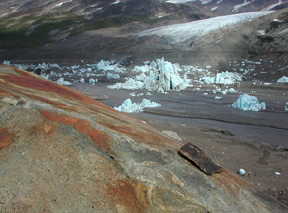Drained lake holds record of ancient Alaska
Drained lake holds record of ancient Alaska
Submitted by Ned Rozell
Phone: 907-474-7468
02/27/08

Not too long ago, a lake sprung a leak in the high country of the Wrangell-St. Elias Mountains. The lake drained away, as glacier-dammed lakes often do, but this lake was a bit different, and seems to be telling a story about a warmer Alaska.
The lake, known as Iceberg Lake to people in McCarthy, about 50 air miles to the north, had been part of the landscape for as long as people could remember. Pinched by glacial ice, the three-mile-long, one-mile-wide lake on the northern boundary of the Bagley Icefield was remote but notable enough that it was the cover photo for a recent book about hiking Wrangell-St. Elias National Park.
When McCarthy guide Richard Villa visited the area with a client in the summer of 1999, he was stunned to see the lake, which had lost much of its water. Villa later told Mike Loso, a Kennicott resident part of the year and now a professor at Alaska Pacific University in Anchorage.
Loso flew to the lake the next summer with Bob Anderson and Dan Doak, scientists who also reside in McCarthy for part of the year. The men saw a muddy lakebed where Iceberg Lake had sat for so long. Streams of meltwater had cut though the mud, making sharp canyons. Loso, Anderson, and Doak hiked into the gullies and saw on the walls many layers of the former lake bottom. They knew that each two layers of sediment--a thinner layer of fine-grained deposits that settled in winter and coarser sand forced in with summer runoff--represented a year in the life of the lake.
"We eyeballed these layers and said ’Wow, there’s at least 1,000 of these things,’" Loso said.
Scientists often pull plugs of sediment from the bottom of lakes to find an ancient record of pollen, dust, ash, and other things that have drifted, or flowed in over the years, but their records usually don’t go back farther than the Little Ice Age, a cold period from about 1600 to 1850 when many glaciers advanced. Those glaciers plowed over most of the landscape, but Iceberg Lake seemed to have escaped the gradual assault.
"(Iceberg Lake) is pinned between these two glaciers just far enough away that it didn’t get overrun by the Little Ice Age (glaciers)," Loso said.
So instead of having a record of just the last few hundred years, the floor of Iceberg Lake held a continuous record from 1998 back to A.D. 442, a span of more than 1,500 years.
That record is unique in that it seems to preserve a time of warmer temperatures called the Medieval Warm Period that happened before the Little Ice Age.
"It’s the most recent time period warm enough to be comparable to the present," Loso said.
When Loso and his colleagues used the thickness of layers (called "varves") to interpret warmth in the area of Iceberg Lake, they found that summer temperatures in that part of the state were warmer in the late 20th century than they were during the Medieval Warm Period.
Not only that, they saw that Iceberg Lake had never drained during the Medieval Warm Period. Since the catastrophic leakage in 1999, the lake has drained of meltwater every year except for 2001. With such erratic behavior after centuries of stability, Iceberg Lake might be saying that Alaska has been warmer recently than it has been in a long, long time.
This column is provided as a public service by the Geophysical Institute, University of Alaska Fairbanks, in cooperation with the UAF research community. Ned Rozell is a science writer at the institute. To view past columns or to subscribe, visit www.gi.alaska.edu/ScienceForum/index.html .


